The Cross Pein Hammer Market is estimated to be valued at USD 4.2 billion in 2025 and is projected to reach USD 6.6 billion by 2035, registering a compound annual growth rate (CAGR) of 4.7% over the forecast period. This five-year period marks a phase of consistent demand driven by increasing construction activities, infrastructure development, and repair and maintenance projects globally. Between 2025 and 2030, the market experiences gradual growth as the construction and manufacturing sectors continue to require durable hand tools for various applications.
The incremental rise from 4.2 to 5.2 billion USD is supported by expanding industrial and residential building projects, which require reliable striking tools for metalworking, woodworking, and general repair. The market benefits from replacement cycles as worn-out hammers are upgraded with newer, more ergonomic, and better-quality variants. Demand from small and medium enterprises in manufacturing and repair services also contributes to market expansion during this period. Though growth is moderate, it reflects the stable and essential nature of cross pein hammers within hand tool portfolios. The market’s progression is aligned with steady industrial activities, construction growth, and ongoing maintenance work worldwide, making it a consistent performer within the broader hand tools industry from 2025 through 2030.
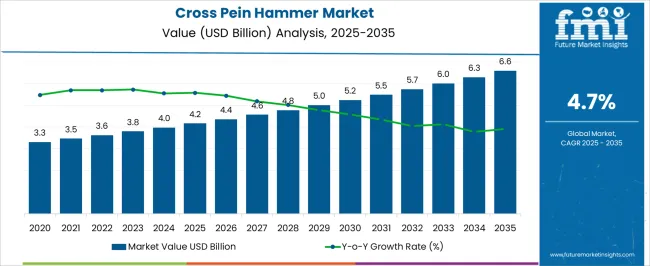
| Metric | Value |
|---|---|
| Cross Pein Hammer Market Estimated Value in (2025 E) | USD 4.2 billion |
| Cross Pein Hammer Market Forecast Value in (2035 F) | USD 6.6 billion |
| Forecast CAGR (2025 to 2035) | 4.7% |
The cross pein hammer market is experiencing steady growth due to increased demand from construction, metalworking, and carpentry industries, coupled with rising adoption of precision hand tools for specialized tasks. Factors such as the durability of steel-based tools, increasing infrastructure investment, and the resurgence of skilled trades are contributing to market expansion.
Technological improvements in forging and heat treatment have enhanced product strength and usability, while manufacturers continue to offer ergonomic designs to reduce fatigue in professional use. Demand for tools compatible with heavy-duty and fine-detail tasks is also growing across both industrial and DIY segments.
Forward momentum is expected to be supported by the growth of renovation projects, commercial construction, and craft-based applications globally, especially in developing economies.
The cross pein hammer market is segmented by product type, material, application, distribution channel, and geographic regions. The cross pein hammer market is divided by product type into Claw cross pein hammers, Straight cross pein hammers, Ball pein cross hammers, and Others (Forged cross pein hammers, etc.). The cross pein hammer market is classified by material into Steel, Wood, Fiberglass, Plastic, and Others (Alloy steel, etc.). Based on the application of the cross pein hammer, the market is segmented into Construction, Metalworking, Woodworking, Automotive, DIY, and Others (masonry, etc.). The distribution channel of the cross pein hammer market is segmented into Offline and Online. Regionally, the cross pein hammer industry is classified into North America, Latin America, Western Europe, Eastern Europe, Balkan & Baltic Countries, Russia & Belarus, Central Asia, East Asia, South Asia & Pacific, and the Middle East & Africa.
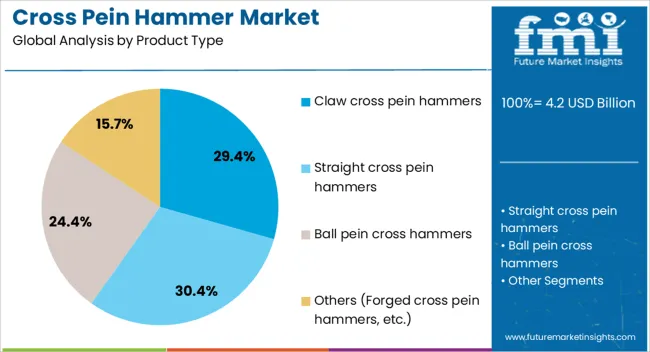
Claw cross pein hammers are projected to hold 29.4% of the revenue share in 2025, making them the leading product type in the market. Their popularity is driven by their dual-purpose design, combining a pein head for shaping and riveting with a claw for nail removal, enhancing versatility for construction and repair tasks.
These hammers have been widely adopted across workshops and field applications where both functionality and tool efficiency are prioritized. Improved availability in multiple weight classes and grip configurations has broadened their user base, particularly among general contractors and artisans.
Their integration into multi-functional toolkits and demand for rugged, adaptable equipment in field settings continue to reinforce their segment leadership.
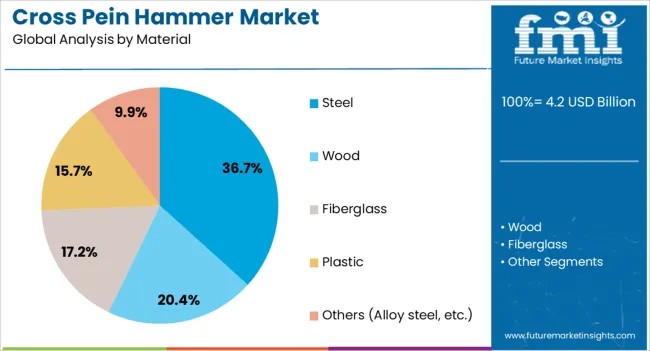
Steel-based cross pein hammers are expected to account for 36.7% of the market share in 2025, positioning them as the top material type. The dominance of steel is attributed to its superior tensile strength, resistance to deformation, and cost-effective production scalability.
Manufacturers have increasingly relied on heat-treated, drop-forged steel for delivering durability under repetitive impact, which is essential for high-stress industrial environments. Steel also offers corrosion resistance when appropriately coated, making it suitable for both indoor and outdoor use.
As quality assurance standards become more rigorous across industrial tool procurement, the preference for standardized, long-lasting materials like steel has solidified its position in the market.
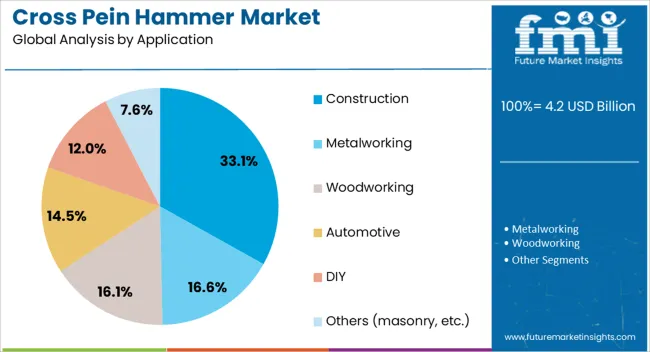
Construction applications are expected to represent 33.1% of the total market share by 2025, establishing this segment as the largest end-use domain. Growth in this segment has been influenced by increasing global investments in commercial and residential infrastructure, along with rising renovation and maintenance activity.
Cross pein hammers are frequently used in framing, structural alignment, and metalworking tasks where directional striking and precision are critical. Their ergonomic advantages and compatibility with modern safety standards have further supported adoption on construction sites.
As emerging economies continue to prioritize affordable housing and urban development, the construction sector's demand for durable hand tools like cross pein hammers is expected to remain consistently high.
The cross pein hammer market is experiencing steady growth driven by demand from construction, metalworking, and woodworking industries. Its specialized design enables precise shaping and riveting tasks, making it essential for skilled labor and industrial applications. Growth in infrastructure projects and increased DIY activities are contributing factors. Challenges include competition from alternative hammer types and the need for ergonomic designs to reduce user fatigue. Innovations in materials, handle design, and vibration reduction are enhancing product appeal. Expansion in emerging markets and adoption in niche trades offer strong growth prospects.
Cross pein hammers are widely used for metal shaping, forging, and woodworking, making them popular in construction and manufacturing. The growth of infrastructure and industrial sectors increases the need for durable and precise hand tools. Skilled tradespeople rely on the hammer’s design for accurate riveting and bending tasks. Additionally, rising DIY culture and hobbyist activities drive retail demand. The market benefits from growth in small and medium enterprises engaged in metal fabrication and carpentry. Manufacturers supplying high-quality, application-specific cross pein hammers find expanding opportunities, particularly where manual craftsmanship remains integral.
Despite their utility, cross pein hammers face competition from multifunctional tools and power-operated alternatives that offer efficiency gains. User comfort is a concern as prolonged use may cause fatigue and strain, creating demand for ergonomic designs with shock-absorbing handles and balanced weight distribution. Material selection impacts durability and cost; cheaper models may fail prematurely, reducing consumer confidence. Ensuring consistent quality and compliance with safety standards is vital. These challenges require continuous product innovation and customer education. Market penetration can be limited in regions with low awareness or preference for traditional hammer types.
Advancements in handle materials such as fiberglass and reinforced polymers improve durability and reduce vibrations, enhancing user comfort and safety. Steel and alloy heads with heat treatment ensure long-lasting performance and resistance to wear. Design refinements focus on optimized weight balance for precision and reduced fatigue. Some manufacturers incorporate anti-slip grips and cushioned handles to improve handling. Customized hammer sizes and head shapes cater to different trades and applications. These innovations enable cross pein hammers to meet evolving user expectations and comply with industry standards, providing a competitive edge in both professional and consumer segments.
Expanding construction and manufacturing activities in emerging economies create strong demand for quality hand tools including cross pein hammers. Growing urbanization and industrialization contribute to increased tool purchases. Retail expansion through online platforms and specialty hardware stores improves accessibility. Partnerships with distributors and tool rental companies further extend market reach. Training programs for skilled labor emphasize the importance of proper tool selection, boosting adoption. However, supply chain disruptions and raw material price fluctuations can impact availability and costs. Companies focusing on regional customization, affordable pricing, and after-sales support are better positioned to capture market share in these developing regions.
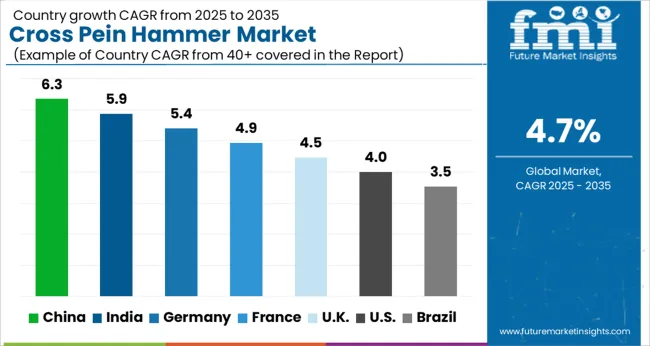
The global cross pein hammer market is growing at a steady 4.7% CAGR, driven by rising demand in construction, metalworking, and maintenance industries. China leads with 6.3% growth, supported by robust manufacturing infrastructure and expanding industrial activities. India follows at 5.9%, fueled by growing construction and fabrication sectors. Germany records 5.4% growth, reflecting high-quality production standards and regulatory compliance. The United Kingdom grows at 4.5%, driven by steady demand from the manufacturing and repair industries. The United States, a mature market, shows 4.0% growth, shaped by stringent quality norms and tool innovation. These countries collectively shape market trends through improvements in durability, ergonomics, and safety standards. This report includes insights on 40+ countries; the top countries are shown here for reference.
China cross pein hammer market is growing at a 6.3% CAGR, propelled by expanding construction, metalworking, and manufacturing sectors. The country’s rapid urbanization and infrastructure projects increase demand for durable and ergonomic hand tools. Local manufacturers focus on producing high-quality steel hammers with improved grip designs to enhance worker safety and productivity. Compared to Western markets, China offers cost-effective products with quick turnaround times, supporting both domestic and export needs. Rising awareness of workplace safety regulations further drives adoption of certified tools.
India cross pein hammer market grows at a 5.9% CAGR, driven by increasing construction activity and metal fabrication industries. Rising investments in affordable housing and infrastructure create steady demand for reliable and affordable hand tools. Compared to China, India’s market is developing with a focus on improving quality and durability. Small and medium enterprises form a large user base, demanding cost-efficient yet robust hammer variants. Skill development initiatives enhance tool usage knowledge and safety compliance, supporting market growth.
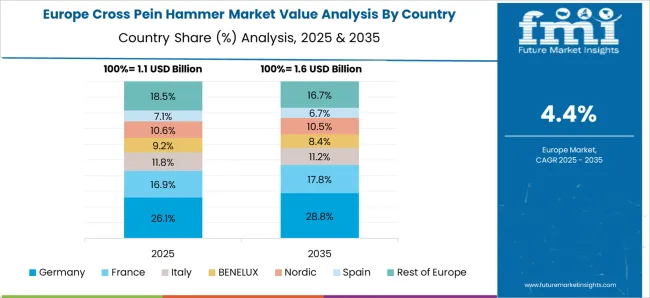
Germany cross pein hammer market grows at a 5.4% CAGR, reflecting mature industrial and construction sectors emphasizing high-quality tools. German manufacturers prioritize premium materials and precision forging techniques to produce durable and balanced hammers. Compared to Asian markets, Germany places more emphasis on tool longevity and compliance with strict workplace safety standards. Specialized hand tool distributors support professional craftsmen and industrial users. Innovations include vibration-dampening handles to reduce fatigue during prolonged use.
United Kingdom market grows at a 4.5% CAGR, supported by steady construction and repair industry demand. UK manufacturers focus on balanced weight and ergonomic handles to enhance usability. Compared to Germany, the UK market is smaller but increasingly favors lightweight, versatile hammer models suitable for various trades. Sustainability trends encourage use of recycled materials in tool production. Partnerships between tool makers and trade schools promote skill development and safety training.
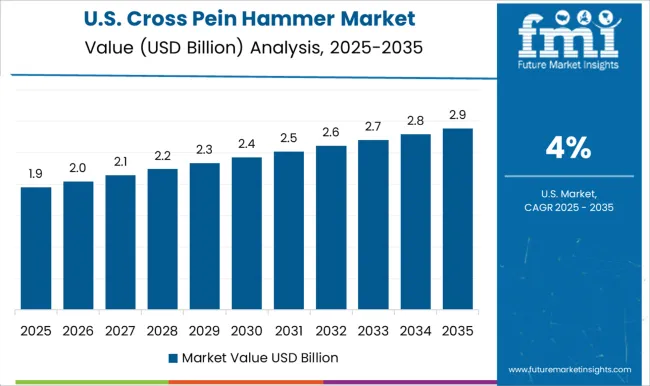
United States cross pein hammer market grows at 4.0% CAGR, driven by diverse construction, metalworking, and maintenance industries. USA manufacturers emphasize quality control and ergonomic design to meet professional standards. Compared to European markets, the USA market has a broad range of specialized hammer variants catering to different applications. Distribution channels include large hardware retailers and industrial suppliers. Growing DIY culture also boosts demand for affordable, reliable tools suitable for home use.
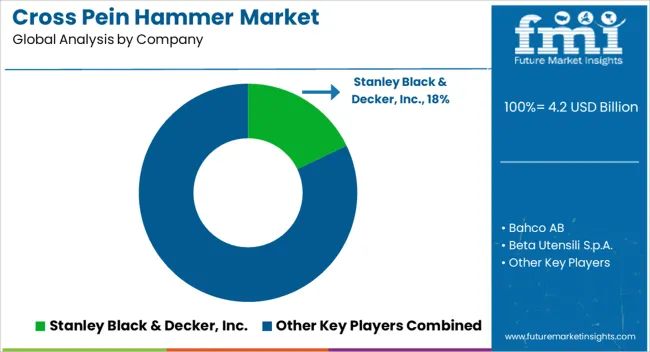
The cross pein hammer market is shaped by a diverse mix of globally recognized manufacturers and specialized toolmakers, each bringing unique strengths to the competitive landscape. Stanley Black & Decker, Inc., Hilti Corporation, and Milwaukee Electric Tool Corporation are some of the dominant players with broad product portfolios, extensive global distribution networks, and strong brand recognition. These companies invest heavily in research and development to enhance hammer durability, ergonomics, and user comfort, appealing primarily to construction professionals and industrial users who require reliable, high-performance tools. On the other hand, European manufacturers such as Bahco AB, Beta Utensili S.p.A., Gedore Tools GmbH, and Knipex-Werk focus on precision engineering and craftsmanship.
These brands emphasize quality materials, innovative design features, and long-lasting performance, often targeting both professional tradespeople and niche markets like metalworking and carpentry. Their tools are known for meticulous build quality and adherence to stringent manufacturing standards, offering an alternative to mass-produced models from larger conglomerates. In contrast, brands like Craftsman and Spear & Jackson Limited cater more to the general consumer and DIY markets, balancing affordability with decent quality.
This creates a market dynamic where premium and precision tools compete alongside more accessible, budget-friendly options. The ongoing challenge for manufacturers is to balance innovation, cost-efficiency, and market reach, ensuring that they meet the evolving needs of both professionals and casual users. This contrast between industrial-grade and consumer-focused products keeps the market competitive and diverse.
Manufacturers are focusing on ergonomic handles to improve user comfort and reduce hand fatigue during long hours of use. Innovations in grip designs and vibration reduction are enhancing the overall user experience, making cross pein hammers more efficient and comfortable for professional users.
| Item | Value |
|---|---|
| Quantitative Units | USD 4.2 Billion |
| Product Type | Claw cross pein hammers, Straight cross pein hammers, Ball pein cross hammers, and Others (Forged cross pein hammers, etc.) |
| Material | Steel, Wood, Fiberglass, Plastic, and Others (Alloy steel, etc.) |
| Application | Construction, Metalworking, Woodworking, Automotive, DIY, and Others (masonry, etc.) |
| Distribution Channel | Offline and Online |
| Regions Covered | North America, Europe, Asia-Pacific, Latin America, Middle East & Africa |
| Country Covered | United States, Canada, Germany, France, United Kingdom, China, Japan, India, Brazil, South Africa |
| Key Companies Profiled | Stanley Black & Decker, Inc., Bahco AB, Beta Utensili S.p.A., Craftsman, Estwing Manufacturing Company, Fiskars Group, Gedore Tools GmbH, Hilti Corporation, Irwin Industrial Tools, Klein Tools, Inc., Knipex-Werk C. Gustav Knipex GmbH & Co. KG, Milwaukee Electric Tool Corporation, Picard Hammer GmbH, Spear & Jackson Limited, and Vaughan & Bushnell Manufacturing Company |
| Additional Attributes | Dollar sales vary by product type, including claw, straight, ball pein, and forged cross pein hammers; by handle material, such as wood, fiberglass, and composite; by application, spanning metalworking, woodworking, construction, automotive, DIY, and masonry; and by region, led by North America, Europe, and Asia-Pacific. Growth is driven by industrial demand, ergonomic innovations, and DIY trends. |
The global cross pein hammer market is estimated to be valued at USD 4.2 billion in 2025.
The market size for the cross pein hammer market is projected to reach USD 6.6 billion by 2035.
The cross pein hammer market is expected to grow at a 4.7% CAGR between 2025 and 2035.
The key product types in cross pein hammer market are claw cross pein hammers, straight cross pein hammers, ball pein cross hammers and others (forged cross pein hammers, etc.).
In terms of material, steel segment to command 36.7% share in the cross pein hammer market in 2025.






Our Research Products

The "Full Research Suite" delivers actionable market intel, deep dives on markets or technologies, so clients act faster, cut risk, and unlock growth.

The Leaderboard benchmarks and ranks top vendors, classifying them as Established Leaders, Leading Challengers, or Disruptors & Challengers.

Locates where complements amplify value and substitutes erode it, forecasting net impact by horizon

We deliver granular, decision-grade intel: market sizing, 5-year forecasts, pricing, adoption, usage, revenue, and operational KPIs—plus competitor tracking, regulation, and value chains—across 60 countries broadly.

Spot the shifts before they hit your P&L. We track inflection points, adoption curves, pricing moves, and ecosystem plays to show where demand is heading, why it is changing, and what to do next across high-growth markets and disruptive tech

Real-time reads of user behavior. We track shifting priorities, perceptions of today’s and next-gen services, and provider experience, then pace how fast tech moves from trial to adoption, blending buyer, consumer, and channel inputs with social signals (#WhySwitch, #UX).

Partner with our analyst team to build a custom report designed around your business priorities. From analysing market trends to assessing competitors or crafting bespoke datasets, we tailor insights to your needs.
Supplier Intelligence
Discovery & Profiling
Capacity & Footprint
Performance & Risk
Compliance & Governance
Commercial Readiness
Who Supplies Whom
Scorecards & Shortlists
Playbooks & Docs
Category Intelligence
Definition & Scope
Demand & Use Cases
Cost Drivers
Market Structure
Supply Chain Map
Trade & Policy
Operating Norms
Deliverables
Buyer Intelligence
Account Basics
Spend & Scope
Procurement Model
Vendor Requirements
Terms & Policies
Entry Strategy
Pain Points & Triggers
Outputs
Pricing Analysis
Benchmarks
Trends
Should-Cost
Indexation
Landed Cost
Commercial Terms
Deliverables
Brand Analysis
Positioning & Value Prop
Share & Presence
Customer Evidence
Go-to-Market
Digital & Reputation
Compliance & Trust
KPIs & Gaps
Outputs
Full Research Suite comprises of:
Market outlook & trends analysis
Interviews & case studies
Strategic recommendations
Vendor profiles & capabilities analysis
5-year forecasts
8 regions and 60+ country-level data splits
Market segment data splits
12 months of continuous data updates
DELIVERED AS:
PDF EXCEL ONLINE
Cross-chain NFT Market Size and Share Forecast Outlook 2025 to 2035
Cross-species Organ Transplantation Market Forecast and Outlook 2025 to 2035
Cross Interconnection Protection Box Market Size and Share Forecast Outlook 2025 to 2035
Hammer Mill Market Size and Share Forecast Outlook 2025 to 2035
Cross Corner Industrial Bags Market Size and Share Forecast Outlook 2025 to 2035
Cross-Linked Polyethylene Market Size and Share Forecast Outlook 2025 to 2035
Cross-Border Road Transport Market Size and Share Forecast Outlook 2025 to 2035
Crossfit Apparel Market Size and Share Forecast Outlook 2025 to 2035
Cross Point Switch Market Size and Share Forecast Outlook 2025 to 2035
Cross Training Shoes Market Size and Share Forecast Outlook 2025 to 2035
Crossover Market Size and Share Forecast Outlook 2025 to 2035
Cross-Cloud Analytics Market Insights - Growth & Forecast 2025 to 2035
Competitive Landscape of Hammer Mill Market Share
Cross-Belt Sorters Market
Cross-linked Shrink Films Market
Cross-Platform & Mobile Advertising Market Report – Growth 2018-2028
Cross Laminated Timber Market
Crosslinking Agents Market
Peg Hammer Market Size and Share Forecast Outlook 2025 to 2035
Motocross Gears Market Outlook – Size, Share & Innovations 2025–2035

Thank you!
You will receive an email from our Business Development Manager. Please be sure to check your SPAM/JUNK folder too.
Chat With
MaRIA